|
Travelogue
Part 4: by Andrew Nickson |
 |
|
A Nepali friend was supposed to be shooting some dumb romantic film in Darjeeling and was to rent a house next to a tea plantation. He invited me for a month of feast and revelry ( he cooks, too ), but it was postponed. So I wandered about waiting...wait is the most common word you’ll hear here. Went up to the mountains (plains too hot, Calcutta 41 degrees) with a Japanese butterfly collector who crept all over the hills with a giant butterfly net. He had a big bag of used clothes to give to poor people. Hill people aren’t ethnic Indians but are originally from China or Mongolia mixed in with the local hill tribes. They’re handsome, tough, stocky, mountain people, eat a lot of meat, wear no shoes in the cold, hold fierce archery contests with the target only 2 inches wide, have 12 children, speak good English, are honest, friendly, and they chew and spit red betel nut all day, women too. Walk too close to a bus full of betel-chewers waiting to leave and splat…all over you. |
| Some hills are dotted with giant standing stones 3, 4, 5 metres high, ancient megaliths used at cremations and secret rites. They still hold weekly markets among these stones. The biggest section is beef, killed on the spot, hanging up in great chunks, the stone gutters flooding with deep crimson blood, the bloody freshly-severed heads placed upside down in a neat row on the narrow stone path like some memory of an old barbaric ritual. Before the Christian missionaries got to them, they used to sacrifice virgins to ensure good crops. Now that this practice is banned, the rainfall has dropped badly and there’s water shortages even in Cherrapunji, until recently ‘the wettest place in the world.’ There’s also a snake spirit cult that has to be fed on human blood to make the devotees rich. It’s frowned on by the majority, so they have to kill secretly, at random at night. One chap said he knew a village that was still sacrificing girls only 10 years ago. I bet they had the best harvests of that province, too. In Madras museum there’s a crude wooden device on which girls were sacrificed to ensure good crops, like a giant plough with an ugly wooden spike sticking up in the middle. And we won’t even mention the tantrics who dig up and eat dead children’s bodies to obtain some power or other. Ah India. Be careful when visiting.... | 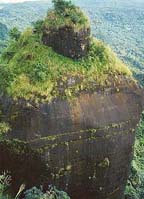 Cherrapunji |
|
A butterfly museum also displays giant spiders, rhino beetles, scorpions, centipedes and so on: the Lao-Khmer, who love all these high-protein delicacies, would call it a museum of tasty food. What would the Nepalis or the Indian Hindus make of all the beef eating? Last month in Nepal a woman was jailed for 12 years for killing a cow, their national animal. In the Hindu towns the cows roam at will, foraging in the rubbish along with the dogs and crows for food. Give a cow a banana peel and you’ve got a friend for life, they follow you around for more. Outside the restaurants wait the scroungers: cows, dogs, beggars, sadhus (men too holy and stoned on hashish to work). Crows, goats and pigs don’t beg, they snuffle and root and mind their own business. Lord Krishna was right, the cows come first, though the completely mad can be very personable -- they laugh if you give 'em money and they laugh if you don’t, quite different from the usual po-faced moochers clogging up the pavement. |
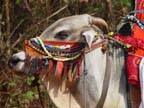 Sacred cow |
| So many different ethnic groups, castes and creeds in India. This time only in the northeast, small states that were made part of India at partition but should be separate self-governing entities, peopled by Bodos, Nagas, Khasi, Garo, Mizus etc. Assam’s Brahmaputra valley with its expanses of tea estates shaded by yellow grevilleas is flat, all the rest is Himalayan foothills. Many different mountain peoples, all tough, all stocky. Here it’s Nepalis of many different sub-groups -- they call the area Gorkhaland and stage periodic rebellions against Delhi -- and Tibetan refugees, complete with monasteries of young monks in maroon and yellow robes playing football between prayers. In Tibet itself young monks spend all their money coming down to Lhasa to prostrate themselves in the stench and smoke of the rancid yak butter lamps of Jokhang temple, then they come up to you, peer right in your face and demand give me money so they can get home. Direct if nothing else. Tibetans eat meat, the Dalai Lama said it’s okay as needed for protein in high altitudes. It’s mostly buffalo, in noodle soups and in dumplings called momo, the best of the mountain cuisine. | 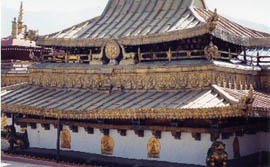 Jokhang Temple |
|
In lower hill areas the wild flowers are lantana, datura, some orchids. Higher up its all large orange marigolds -- the flower of choice for garlands to hang on statues and celebrities -- and Indian hemp. Army everywhere up here as a) near Chinese border and b) many local tribal groups fighting for independence, daily deaths from bombings, kidnappings etc. High above Kalimpong a sign reads Army environmental park but it’s only the officers’ golf course, probably a neat funding ploy. State elections currently under way, pollies shouting into microphones haranguing the masses. Public libraries are used to hold the votes for the counting period so all are closed for 6 weeks, guarded by army boys who smile engagingly as they raise their guns to prevent you entering. Another excuse for non letter writing, yeah ? Even mountain dogs are healthier than their mangy plains counterparts ( down Shiva ! sit Ganesh ! Hanuman, stop monkeying around ! ). With the muezzin's 4 a.m. call the dogs start howling. Are they, to use a well-worn Muslim tautology, Hindu dogs ? Or is it just the joie de barking in the same way that the intense over-use of ear-splitting horns by all Indian car, truck and motorbike drivers is sheer joie de klaxon ? The plains though has heat like its going out of style, 42, 43 common this season, early this year. |
 Orange marigolds |
|
Great Indian
enthusiasm number 1: tea. It’s boiled up with milk and sugar
all together, a bit sweet but you get used to it and they only drink
it in very small cups. Very refreshing when flavoured with cardamom
or ginger: ask for masala or special tea. You can learn to ask for
it without sugar but so many languages here that you need to learn
it again and again in a new tongue. ( There’s 17 official major
languages - currency notes have the amount written in all 17 - plus
hundreds of minors. ) Tea is so important that in Indian movies
the tea lady is mentioned in the credits. Tea and the newspaper
to go with it are the greatest bargains in the country, 4 or 5 cents
each. |
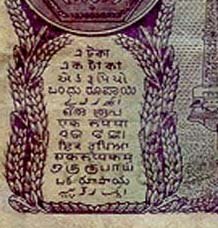 Languages on back of one rupee note |
|
Great Indian enthusiasm number 2: cricket. Cricket is so important that match scores feature on the business channel with stock prices and exchange rates. The crowd rioted when an important cricket match was cancelled due to rain. Indians riot at the drop of a hat. Voters rioted when the opposition tried to stop free distribution of booze by a government candidate. Students even riot when not allowed to cheat in the examinations. The boundless energy of these people is mostly wasted on politics, manipulated and exploited by religious/political interests. Too much politics altogether in India, benefitting no-one but the politicians and their cronies. Governments change but little else does. At least cricket enthusiasm is innocently entertaining, so entertaining in fact that sociologists reckon communal strife lessens during test matches….howzat ! |
 Indian cricket players |
The plains are crisscrossed by an intricate rail network, astoundingly efficient given the volume of traffic. Mind you, carriages can become so crowded that even the vendors give them a miss, and they can squeeze in anywhere: see the stateroom sequence from the Marx brothers film A night at the opera for some idea of the crush. But no matter, you don’t have to leave your seat: basics like tea, meals, water, newspapers will come to you, plus everything else from jewellery, furniture, clothing, you name it. Bridges across the many huge rivers ( in full annual flood the Brahmaputra is 60 kilometers wide: it has black river dolphins, giant cat fish, huge storks and other long-legged water birds. A chap said see those birds there that look like cormorants, they’re from Siberia and will leave to go back later this week and by Vishnu, he was right ), Tunnels through the many hills, stations hundreds of yards long. It’s one of the great train countries, India, together with China. |
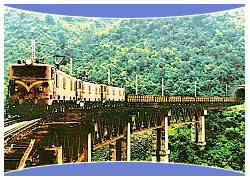 Railway |
|
Indian English is a delight. Commit no nuisance here written on a wall means "no pissing." Common signs include: Hooking is a punishable offence. No spitting (this one even in cinemas, understandably enough given that betel stain is thoroughly indelible). We serve all kinds of Indian-made foreign liquor. Stick no bills: hang no banners. Please do not pluck the flowers. Hotels offer fooding and lodging. Tailors offer shirtings and suitings. They ask on the train, "Where are you dropping? Will you be tea having? And what is your good name? Coming from where?" Signs in the Calcutta metro request passengers not to sit gossipping on the steps and not to spread rumours. Tora tora in Hindi means a little but a single tora means something: asked if they speak English they reply, "Something something." Written English is declining rapidly, especially in the north, which prefers Hindi, so you get approximations instead such as menus offering corn flex. Breakfast at a cavernous bakery-cum-tea shop run by wild red-bearded Mohammedans. Lunch at a mountain rice stall squashed along the wall, plate on knees, or in a tiny Tibetan wooden cafe where you have to stoop down to enter and sit in curtained-off booths. Dinner in a Hindu thali cafe, pure veg or maybe a small fish. In recently-opened northeast areas (permits still needed for some places but you can sneak in for the day ) you’ll be the only foreigner there and get offered so many teas and cakes and sweets you’ll have to rack your brain inventing new excuses how to gratefully decline this genuine hospitality. As always in Asia, tea shops and trains are the best way to meet people and hear their opinions. You’ll hear it all, from complaints about illegal Bangladeshis to the lady who said that since there are so many Indians in Britain the queen should wear a sari occasionally, it would be a gracious gesture and would really suit her, she’d look great. That’s it. Just heard that the Nepali flick has been cancelled altogether, so that really is it. The dogs bark and the caravan moves on. |
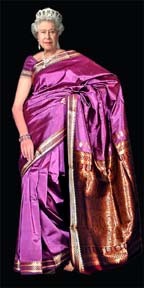 Queen Liz in a sari, through the magic of Photoshop |
Andrew Nickson was born in Melbourne, Australia and educated in England and France. He has temporarily made his home in India, China, the U.S. and France but has spent most of his fascinating life traveling and reading literary works from all over the world. He claims to have visited every nation on earth.
Copyright©EighthSquare.com P.O. Box 580 New York, NY 10113
